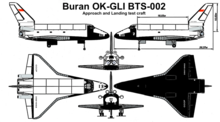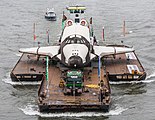OK-GLI
The OK-GLI (Russian: Орбитальный корабль для горизонтальных лётных испытаний, ОК-ГЛИ, romanized: Orbital'nyy korabl' dlya gorizontal'nykh lotnykh ispytaniy, lit. 'Orbital ship for horizontal flight tests'), also known as Buran Analog BTS-02 (Russian: БТС-02, Большой транспортный самолёт второй, romanized: bolshoi transportny samolyot vtoroi, lit. 'big transport aircraft, the second'), was a test vehicle ("Buran aerodynamic analogue") in the Buran programme. It was constructed in 1984, and was used for 25 test flights between 1985 and 1988 before being retired. It is now an exhibit at the Technik Museum Speyer in Germany.
Atmospheric Buran testbed currently on display in Technik Museum Speyer | |
| Construction number | OK-0.02 |
|---|---|
| Country | Soviet Union |
| Status | At the Technik Museum Speyer, Germany |
| First flight | Flight 1 10 November 1985 |
| Last flight | Flight 25 15 April 1988 |
| No. of missions | 25 test flights |
Construction
The development of the Buran began in the late 1970s as a response to the U.S. Space Shuttle program. The construction of the orbiters began in 1980, and by 1984 the first full-scale Buran was rolled out. The first suborbital test flight of a scale-model took place as early as July 1983. As the project progressed, five additional scale-model flights were performed.
The OK-GLI (Buran Analog BST-02) test vehicle ("Buran aerodynamic analogue") was constructed in 1984. It was fitted with four AL-31 jet engines mounted at the rear (the fuel tank for the engines occupied a quarter of the cargo bay). This Buran could take off under its own power for flight tests, in contrast to the American Enterprise test vehicle, which was entirely unpowered and relied on an air launch.
The jets were used to take off from a normal landing strip, and once it reached a designated point, the engines were cut and the OK-GLI glided back to land. This provided invaluable information about the handling characteristics of the Buran design, and significantly differed from the carrier plane/air drop method used by the US and the Enterprise test craft.
Test flights

Nine taxi tests and twenty-five test flights of the OK-GLI were performed,[1] after which the vehicle was "worn out". All tests and flights were carried out at Baikonur.
| Date | Description | Maximum speed | Maximum altitude | Time | Crew/notes[2] |
|---|---|---|---|---|---|
| 29 December 1984 | Taxi test 1 | 45 km/h | 5 minutes | Rimantas Stankevičius, Igor Volk | |
| 2 August 1985 | Taxi test 2 | 200 km/h | 14 minutes | Rimantas Stankevičius, Igor Volk | |
| 5 October 1985 | Taxi test 3 | 270 km/h | 12 minutes | Rimantas Stankevičius, Igor Volk | |
| 15 October 1985 | Taxi test 4 | 300 km/h | Rimantas Stankevičius, Igor Volk | ||
| 10 November 1985 | Flight 1 | 480 km/h | 1500 m | 12 minutes | Rimantas Stankevičius, Igor Volk |
| 15 November 1985 | Taxi test 5 | 170 km/h | 12 minutes | Rimantas Stankevičius, Igor Volk | |
| 3 January 1986 | Flight 2 | 520 km/h | 3000 m | 36 minutes | Rimantas Stankevičius, Igor Volk |
| 26 April 1986 | Taxi test 6 | 14 minutes | Anatoli Levchenko, Alexandr Shchukin | ||
| 27 May 1986 | Flight 3 | 540 km/h | 4000 m | 23 minutes | Rimantas Stankevičius, Igor Volk |
| 11 June 1986 | Flight 4 | 530 km/h | 4000 m | 22 minutes | Rimantas Stankevičius, Igor Volk |
| 20 June 1986 | Flight 5 | 600 km/h | 4500 m | 25 minutes | Anatoli Levchenko, Alexandr Shchukin |
| 28 June 1986 | Flight 6 | 650 km/h | 5000 m | 23 minutes | Anatoli Levchenko, Alexandr Shchukin |
| 10 December 1986 | Flight 7 | 700 km/h | 4000 m | 24 minutes | First automatic landing Rimantas Stankevičius, Igor Volk |
| 23 December 1986 | Flight 8 | 750 km/h | 6000 m | 17 minutes | Rimantas Stankevičius, Igor Volk |
| 29 December 1986 | Flight 9 | 17 minutes | Anatoli Levchenko, Alexandr Shchukin | ||
| 16 February 1987 | Flight 10 | 28 minutes | Rimantas Stankevičius, Igor Volk | ||
| 25 February 1987 | Flight 11 | 19 minutes | Rimantas Stankevičius, Igor Volk | ||
| 29 March 1987 | Taxi test 7 | 2 minutes | Anatoli Levchenko, Alexandr Shchukin | ||
| 30 March 1987 | Taxi test 8 | 25 minutes | Anatoli Levchenko, Alexandr Shchukin | ||
| 21 May 1987 | Flight 12 | 20 minutes | Anatoli Levchenko, Alexandr Shchukin | ||
| 25 June 1987 | Flight 13 | 19 minutes | Rimantas Stankevičius, Igor Volk | ||
| 5 October 1987 | Flight 14 | 21 minutes | Automatic landing Shchukin, Igor Volk | ||
| 15 October 1987 | Flight 15 | 19 minutes | Ivan Bachurin, Alexei Borodai | ||
| 16 January 1988 | Flight 16 | Rimantas Stankevičius, Igor Volk | |||
| 24 January 1988 | Flight 17 | Ivan Bachurin, Alexei Borodai | |||
| 23 February 1988 | Flight 18 | 22 minutes | Rimantas Stankevičius, Igor Volk | ||
| 4 March 1988 | Flight 19 | 32 minutes | Rimantas Stankevičius, Igor Volk | ||
| 12 March 1988 | Flight 20 | Ivan Bachurin, Alexei Borodai | |||
| 23 March 1988 | Flight 21 | Ivan Bachurin, Alexei Borodai | |||
| 28 March 1988 | Flight 22 | Ivan Bachurin, Alexei Borodai | |||
| 2 April 1988 | Flight 23 | 20 minutes | Rimantas Stankevičius, Igor Volk | ||
| 8 April 1988 | Flight 24 | Rimantas Stankevičius, Igor Volk | |||
| 15 April 1988 | Flight 25 | 19 minutes | Rimantas Stankevičius, Igor Volk | ||
| 29 December 1989 | Taxi test 9 | Rimantas Stankevičius, Viktor Zabolotski |
Post-retirement
Zhukovsky Air Base
After the program was cancelled, the OK-GLI was stored at Gromov Flight Research Institute, near Moscow, where it was displayed during the annual MAKS air show.
Sydney, Australia
In 2000, the OK-GLI was sold to an Australian company called the Buran Space Corporation, owned by Australian astronaut Paul Scully-Power. It was disassembled and transported by ship to Sydney, Australia, via Gothenburg, Sweden;[3] arriving on 9 February 2000 and appeared as a static tourist attraction under a large temporary structure in Darling Harbour for a few years.[4][5]
Upon reassembly, the OK-GLI was put on display in a temporary enclosure for the 2000 Summer Olympics in Sydney. Visitors could walk around and inside the vehicle (a walkway was built along the cargo bay), and plans were in place for a tour of various cities in Australia and Asia. The owners went into bankruptcy after the Olympics, and the vehicle was moved into the open air and stored for a year, in a fenced-in parking lot and protected by nothing more than a large tarpaulin, where it suffered deterioration and repeated vandalism.[6]
The OK-GLI was then offered for sale, including by a radio auction on the American News 980 KFWB-AM with a starting price of US$6 million,[7] however it did not receive any genuine bids.[8]
Bahrain
In September 2004 a team of German journalists found the OK-GLI in Bahrain, having been abandoned after it was on display as an attraction of the 2002 "Bahrain Summer" festival.[9][10]
It was then bought by the Sinsheim Auto & Technik Museum, to be transported to Germany in 2005.[11] Due to legal issues, it remained in Bahrain for several years, pending settlement of an international court case over fees.[12]
Technik Museum Speyer, Germany
On 4 March 2008 the OK-GLI began its journey by sea to the Technik Museum Speyer where it was refurbished and serves as a walk-in exhibit.[13]
The journey got off to an inauspicious start when, during the transfer from the storage barge to the ship, there was a failure of the aft spreader (part of the lifting mechanism) and the tail of the vehicle dropped from just above deck height to the bottom of the hold. No one was hurt and both the ship and vehicle seemed to suffer only minor damage.
See also
- Buran (spacecraft) – Buran spacecraft 1.01
- MAKS (spacecraft) - Soviet air-launched spaceplane concept
- Mikoyan-Gurevich MiG-105 – Soviet spaceplane test program
- Space Shuttle Enterprise - American Space Shuttle atmospheric test article
- Space Shuttle program - American spaceplane program
- Tupolev OOS - Soviet air-launched spaceplane concept
References
- "Buran Energia Timeline History". Krzys Kotwicki. Retrieved 4 August 2006.
- "Buran Analogue Chronology". Encyclopedia Astronautica. Retrieved 5 August 2006.
- "Transporting the Russian Space shuttle Buran". ProCargo. Archived from the original on 10 February 2006. Retrieved 2 July 2006.
- "Buran Analogue/002 in Sydney". Suburbia.com.au. Retrieved 2 July 2006.
- Pearlman, Robert Z. (10 February 2000). "Russian shuttle lands down under". collectSPACE. Retrieved 2 July 2006.
- "Analog Buran Test Vehicle". Aerospaceweb.org. Retrieved 15 June 2009.
- Banke, Jim (9 May 2002). "Russian Shuttle Buran, Slightly Used, Goes Up for Auction Today". Space.com. Archived from the original on 15 November 2006. Retrieved 3 July 2006.
- Banke, Jim (23 May 2002). "Auction Fails to Sell Buran, Russian Shuttle Remains Available". Space.com. Archived from the original on 29 August 2008. Retrieved 3 July 2006.
- "Analog shuttle, OK - GLI". Buran-energia.com. Retrieved 28 February 2016.
- Becker, Markus (22 September 2004). "Kurioser Fund: Sowjet-Shuttle am Persischen Golf aufgetaucht" [Strange find: Soviet shuttle found in the Persian Gulf]. Der Spiegel. Retrieved 5 August 2006.
- Becker, Markus (23 September 2004). "Überraschender Handel: Sinsheimer Museum kauft den Sowjet-Shuttle" [Surprising trade: Sinsheimer museum buys the Soviet shuttle]. Der Spiegel. Retrieved 5 August 2006.
- "Buran case review set". Gulf Daily News. 19 June 2007. Retrieved 16 November 2007.
- "Touchdown at Technical Museum: Russian Space Shuttle Navigates Rhine River". Der Spiegel. Reuters. 7 April 2008. Retrieved 7 April 2008.
Further reading
- Elser, Heinz; Elser-Haft, Margrit; Lukashevich, Vladim (2008). History and Transportation of the Russian Space Shuttle OK-GLI to the Technik Museum Speyer. Technik Museum Speyer. ISBN 978-3-9809437-7-2.
External links
| Wikimedia Commons has media related to OK-GLI. |
- OK-GLI at Buran-Energia.com
- Buran Analogue entry at Encyclopedia Astronautica
- OK-GLI at K26.com
- OK-GLI at Technik Museum Speyer






